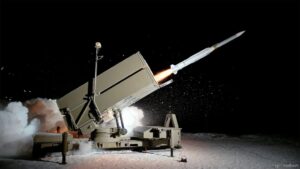Raytheon cites successful test of advanced air missile reconfigured for ground launch
The Raytheon division of RTX (NYSE: RTX) — that has its missile-building operation based in Tucson — has announced the successful completion of a flight test of an updated version of an extended-range air-to-air missile that was reconfigured as a surface-to-air system.
The test — which took place recently in Norway with the participation of Kongsberg Defence & Aerospace and the Norwegian military — configured an extended-range missile from the Advanced Medium Range Air-to-Air Missile, or AMRAAM-ER, program to incorporate the guidance section from the AIM-120C-8 missile. A rocket motor from Norwegian company Nammo and a control actuator system from Kongsberg were also used in the upgrade.
The missile was launched from a National Advanced Surface-to-Air Missile System, or NASAMS, launcher and flew a preprogrammed flight path.
The extended range weapon is designed to work with the launcher as a way to enhance air defense capabilities by reaching targets farther or higher than could be intercepted by other AMRAAM weapons.
Raytheon said the test demonstrates the increased capabilities and safety of the upgraded AMRAAM-ER.
AMRAAM program, which is part of the U.S. military’s Form, Fit, Function Refresh program — also known as F3R — that updates missile hardware and allows for software upgrades. Raytheon has previously highlighted how adjustments made in the program can adapt to advanced threats.
“Integrating this new technology into the AMRAAM-ER ensures the advanced capabilities of the surface-launched munition for many years to come,” said Paul Ferraro, president of Air & Space Defense Systems at Raytheon, in a statement. “Agile software upgrades will continue to advance AMRAAM to stay ahead of evolving threats.”
Raytheon in Tucson has been a longtime participant in the AMRAAM program. Just last summer, the manufacturer announced a successful live-fire test of an AIM-120D-3 missile — the most advanced AMRAAM variant — from a U.S. Navy F-16 fighter jet. A few months later, the U.S. Air Force completed the first flight test of the AIM-120C-8 missile.
Those tests came shortly after Raytheon won a contract for more than $1.15 billion in June 2023 to continue its work in the AMRAAM program for the Air Force, Navy and foreign militaries. And in September 2022, Raytheon won a $972 million deal for hardware and software for AIM-120D3 and AIM-120C8 missiles.
The NASAMS system was jointly developed by Raytheon and Kongsberg, and it is in use by several nations. Raytheon won a $182 million contract in August 2022 to midrange surface-to-air missiles from the program to the Ukrainian military for use in its war with Russia.
In an unrelated deal, the Department of Defense announced on Feb. 27 that Raytheon in Tucson was awarded a $73,919,678 contract modification to exercise options to provide engineering and technical support for Standard Missiles Two and Six. The contract comes through the Navy with involvement from Australia. Nearly all the work will take place in Tucson.

